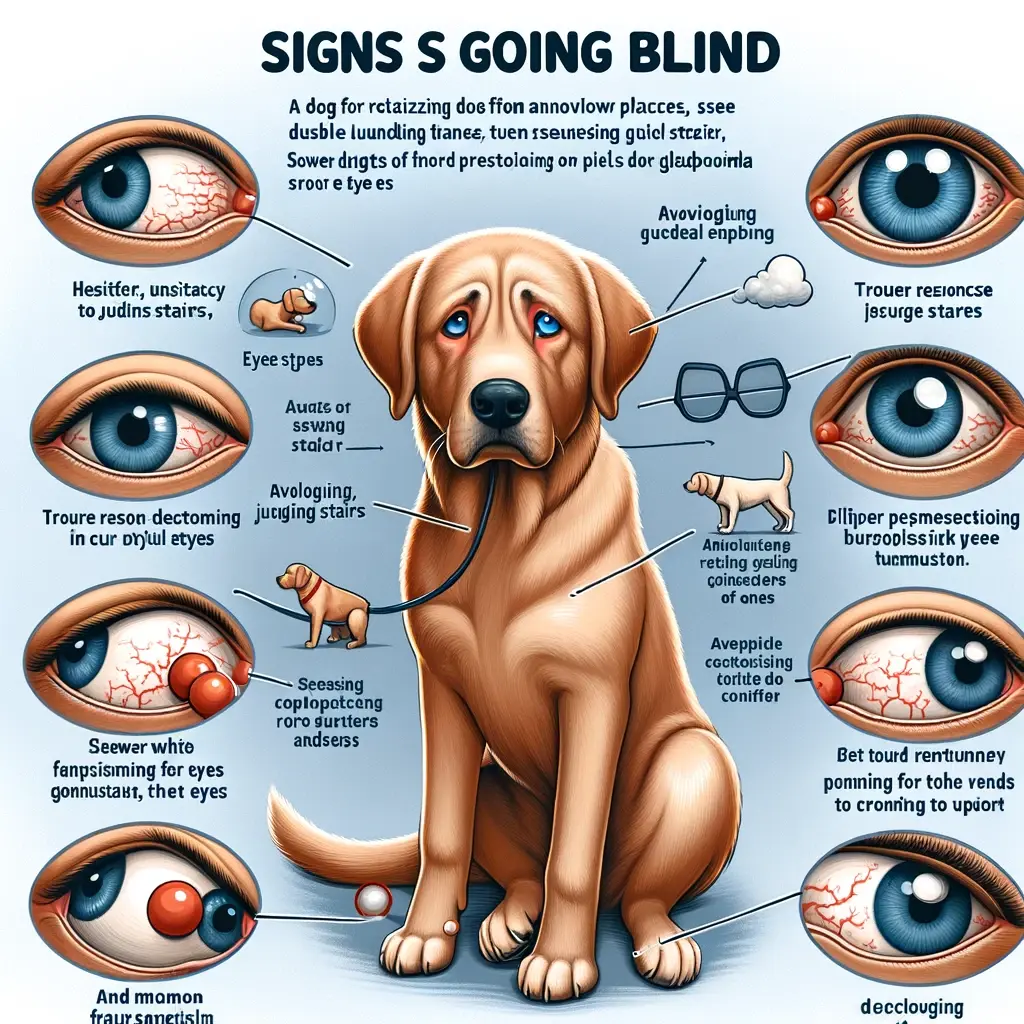Summary
To tell if your dog is going blind, observe behavioral changes like hesitation in new places, difficulty with stairs, and clumsiness. They may bump into objects or have trouble finding toys. Look for physical signs such as cloudy eyes, white spots, dilated pupils not reacting to light, or increased eye discharge. At home, test their vision by observing if they follow a dropped toy or react to a hand moving towards their face (menace response). Consult a vet for diagnosis and treatment options, which vary depending on the cause of vision loss (e.g., cataracts, glaucoma). Adapt your home to ensure a safe and comfortable environment for a dog with declining vision.
How to Tell if Your Dog is Going Blind?
Vision in dogs doesn’t decrease in a day or two. It is a gradual process that may take months or even years. This gradual decline is quite positive. You can notice the earlier signs and take precautionary steps to reduce this pace further further.
Therefore, knowing about different signs your dog may show during the initial phase of vision loss becomes essential.
Before heading towards clinical symptoms, it is crucial to understand your dog’s day-to-day lifestyle changes. If you observe any of the following signs, you should take your dog to a vet for further testing and treatment.
Sudden Behavioral Changes
Dogs are known for their strength, courage, and loyalty. Strong senses, including vision and smell, enable them to perform most tasks demanding proper attention and observation. But lowering vision can steal these qualities instantly.
A dog with poor eyesight starts acting in a hesitant and scared manner, usually at the time of visiting an unknown place.
This may even affect the behavior patterns of your pet and often creates a panic situation in the house. Being a parent of a pet dog, you need to address this issue seriously and look for methods that can improve the deteriorating condition.
Trouble in Judging the Staircase
Dogs’ poor vision seeds the plant of misjudgment in their minds. Even a tiny staircase can become a huge challenge for your furry friend.
If you notice that your dog, already familiar with the stairs, misestimated the steps while moving up or down, it can indicate depleting vision power.
Moreover, increased cases of falling from the staircase also spark the concern that your dog has an eyesight problem.
Loss of Ability to Finish Tasks Quickly
Dogs tend to accomplish their daily tasks quickly without demanding much precious time from their owners.
However, declining vision and partial blindness can significantly reduce their reaction time to the given commands. Running in the streets is strenuous because of the high fear level of moving objects.
You have to prevent your dog from going into low-light conditions. Furthermore, you can arrange bright objects in the dog’s room to help them regain their lost confidence and strength.
Other Possible Lifestyle Signs
In addition to the above changes, the presence of a few other signs can tell you that your dog is going blind. Dogs stop making eye contact with their owners when they can’t identify their faces correctly.
Continuous jumps to or from the couch and the increased desire to get emotional support show the urgent need to meet the vet to identify the reasons behind them.
Formation of Clouds in Eyes
It is one of the most common clinical signs that a dog going blind can show. The creation of a gray-blue hue or cloud-like formation in the eyes is an indicator of cataract or glaucoma. You can observe other symptoms, such as discharge from the eyes, nuclear sclerosis, and corneal dystrophy.
Evolving White Spots
Consulting the vet is a much-needed measure if you see white spots in their eyes. These white spots are the collection of calcium or lipids around the cornea, blocking the passage of light from falling clearly on the lens. They usually evolve into big spots covering the entire lens area.
Improper Functioning of Pupil
This aspect often drives blindness in dogs. Dogs’ pupils function similarly to humans’ pupils.
This means the pupil enlarges and narrows down in darker and brighter conditions.
If the pupil stops contracting during extremely bright situations, it indicates that the dog is going blind.
Presence of Thick Mucus Around the Eyes
Tears’ absence leads to thick mucus forming the corners of the dog’s eyes. When dogs suffer from chronic dry eyes, their body discharges thick mucus to provide moisture to the eyes. But it blocks normal vision and reduces the power to focus on objects.
In such a scenario, you must immediately visit your vet to obtain the medications and treatment for your furry friend.
How to Conduct Easy Tests at Home?
Apart from noticing the different signs, you can also know your dog’s eyesight condition by performing practical tests.
To understand the pupil’s functioning, you can light a torch to check for the contraction of the pupil. It must be done carefully as it may impact the dog’s normal vision.
Menace Response Test, a form of reflex test, is also considered to be effective in knowing whether the dog is going blind or not.
In this test, you must place your open hand 18 inches from your dog’s eyes.
Move your hand in a manner that can lead to the creation of an air current.
However, maintain a proper distance (preferably 2 inches) of your hand from the dog. You need to see if the dog blinks his eyes at this sudden action.
Another quick test can also be done at the house only. Take one of your dog’s favorite toys and drop it from a height above the level of his head. If his vision is proper, the dog will follow the visual direction of the toy.
Treatment Methods to Cure the Vision of Dogs
The effectiveness of dog blindness treatment depends on the reason that has led to vision loss in your dog and the stage at which it is detected. Research studies have shown that two-fifths of dogs suffering from glaucoma become utterly blind as the ailment progresses.
Similar can happen in the case of cataracts if not treated at the right time. You don’t need to worry when your dog suffers from minor trauma due to an infection or accident. It is usually corrected by providing the appropriate help.
Several dog owners search for various methods to cure glaucoma in their pet dogs. However, the lack of information can make the condition worse.
You should visit the vet for regular checkups and use the medications provided to decrease the pressure from the eyes.
In the worst-case scenario, removing the eye through surgery is typically recommended.
Surgeries often help restore the vision of dogs with cataracts in their eyes. However, the effect of treatment varies for different breeds.
This can save a dog from going blind. Moreover, the cost of treatment may be high, so you should get paws’ pet insurance when your dog is just a puppy.
How to Live a Happy Life with a Blind Dog?
The future is uncertain, and no one knows what can happen the very next moment. Even after furnishing the proper treatment, restoring the dog’s vision is difficult. So, it becomes essential for you to understand how you can have a great time with your blind dog.
- First of all, you can make use of the other senses of your furry friend. Dogs are blessed with excellent smelling abilities. You can put flavor extracts or scents in essential corners of the house. Follow this practice even for your dog’s toys so that the dog can have a fun time every day.
- Next, you have to make the home safer for your dog, considering the potential external threats as well.
- Always speak or walk with heavy feet whenever you approach your dog. It will prevent the dog from sudden shock and allow him to decide accordingly.
- Only allow strangers to pet your dog with verbal communication. Provide training to your dog to respond to only specific commands.
- Patience is the Key. Never force your dog to do a specific thing. If he is facing difficulty learning a particular command, give him enough time and maintain a positive atmosphere in the house.
Thus, several dogs’ signs and actions indicate his eyes’ existing health. Early diagnosis of symptoms, appropriate treatment, and patience can do wonders for your dog. Hence, thorough knowledge of symptoms and vision tests can tell if your dog is going blind.
That’s why, at that point, it is the responsibility of the dog parent to understand the dog’s condition and take effective measures quickly by knowing how to tell if your dog is going blind.


